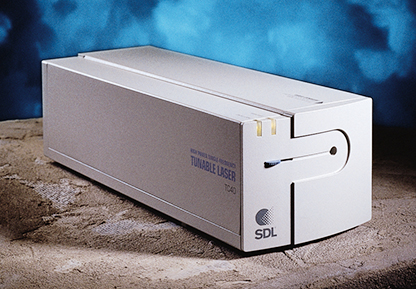Power Play—Laser Style
Exciting research in the areas of physical chemistry, biochemistry, and atomic physics can be studied utilizing the first commercially available single-frequency laser diode system.
SDL, Inc., San Jose, California, is a leader in the design, manufacture, and sale of semiconductor lasers, optoelectronic integrated circuits, and system and fiber optic-related products.
With partial support from the Ames Research Center's (ARC's) Small Business Innovation Research (SBIR) program, SDL has demonstrated and started marketing the first high-power, single-frequency continuously tunable laser diode system suitable for high-precision spectroscopy. High power gives the laser unprecedented attributes. Tapping more than a half watt of power, the SDL TC40 laser operates in the mid-infrared spectral regions. With frequency doubling, laser light in the UV and visible regions can be generated. It has several advantages over other mid-infrared lasers, including high reliability, lower power consumption, room temperature operation, and compact size.
The NASA connection to the laser's creation is part geological, part biological, and part atmospheric. Mid-infrared laser sources are of interest because many geologically and biologically important gases have strong absorption lines in this spectral region. Absorption is the process in which radiant energy is retained by a substance.
Absorption spectroscopy can perform simple, direct measurements of gas concentrations. Measurement of the ratio of carbon dioxide gases is particularly important for tracing material sources and studying biological activity.
Sometime in the 21st century, human crews will adventure to Mars. Those future missions are likely to include onboard mid-infrared laser sources for analysis of Mars rock and soil and atmosphere.
Mid-infrared spectroscopy has several additional NASA applications, including the monitoring of gas concentrations in spacecraft cabins, measuring atmospheric gas concentrations, and analyzing meteorites.
Commercial applications for mid-infrared gas sensing include pollution monitoring of factory and automobile emissions.
"With complete electronic control of scanning, power and modulation, in amplitude as well as frequency, and no optical adjustments, the laser can be put to work within minutes of its arrival," says Milan Zeman, SDL's Product Marketing Manager for instrument and medical systems. By greatly reducing both the equipment and personnel costs of entry, the tunable laser enables researchers with limited budgets to pursue important scientific study, Zeman adds.
Part of the Ames SBIR support led to laser prototypes for high resolution spectroscopy applications. Spectroscopic measurements throughout the visible to mid infrared can be used for process control in semiconductor manufacturing, where monitoring of moisture content, metallizations, epitaxial depositions, and optical coatings can increase device yields. Other industrial chemical processes could be monitored by the laser as well.
SDL's products are focused on two principal markets. The first is composed of applications where optoelectronic solutions are replacing electronic-based systems. The second market uses optoelectronic products as replacement light sources for conventional optical technologies. SDL is focusing on an array of telecom, cable television, networking and satellite communications applications that predominantly fall into those two categories.
The building of high-power, single-frequency continuously tunable laser diodes will enable further expansion of new spectroscopic applications. By offering performance that was previously available only from tabletop-sized complex laser systems, this laser diode technology is expected to bring powerful analytical techniques out of development laboratories and into widespread commercial use.

High-power, single-frequency continuously tunable commercial laser diode system. The compact system opens up research prospects for studies in biological and atmospheric processes, and for pollution monitoring.













